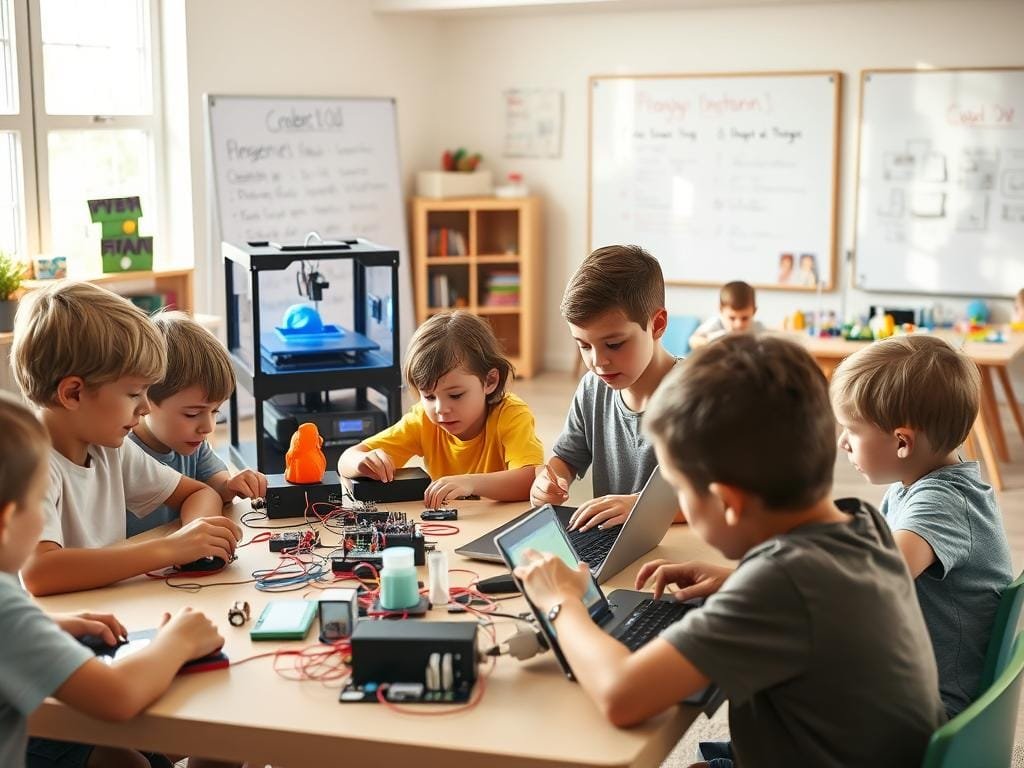Did you know coding is a key skill for over 75% of the fastest-growing jobs in the U.S.? Teaching your kids coding games for kids can be both fun and educational. It sets them up for success in a digital world.
As technology gets better, knowing how to code is more important. Kids coding classes are a great start. They teach kids to solve problems, think logically, and be creative through fun DIY projects.
By doing fun coding activities, your kids can learn important skills for life. They can use apps, games, or even physical computing to make learning to code fun.
Key Takeaways
- Introduce your kids to coding through fun DIY projects and interactive games.
- Coding is an essential skill for the future, applicable in many areas of life.
- Kids coding classes can enhance problem-solving skills and logical thinking.
- Engaging in coding activities can foster creativity in children.
- There are various methods to make learning to code enjoyable, from apps to physical computing.
Why Coding Skills Matter for Today’s Children
In today’s world, coding skills are key for kids to learn. Understanding and creating technology is vital for the next generation.
Digital Literacy in the 21st Century
Digital literacy goes beyond just using devices. It’s about knowing how they work and creating content. Coding activities for children help kids understand and interact with technology better.
Cognitive Benefits of Learning to Code
Learning to code boosts problem-solving, logical thinking, and creativity. Online coding for kids makes learning fun and engaging. It helps kids develop these important skills.
Future Career Opportunities
The job market wants tech-savvy people, and coding skills are in high demand. By teaching coding resources for kids early, we prepare them for tech careers.
Teaching kids to code prepares them for a tech world. It also boosts their cognitive skills and opens career doors.
Getting Started: Age-Appropriate Coding for Kids
Teaching coding to kids is now more important than ever. It’s key to match the coding lessons to the child’s age. This ensures they learn well and have fun.
Preschoolers (Ages 3-5): Pattern Recognition and Sequencing
For preschoolers, coding is about learning basic skills. They can sort toys by color or shape. They can also make simple patterns with blocks.
Apps for young kids can teach coding through games. These apps make learning fun and easy.
Elementary School (Ages 6-10): Visual Programming Basics
Elementary school kids can start learning visual programming. They use block-based coding platforms. Websites like Scratch or Blockly let them make animations and games.
They learn about loops, conditionals, and sequences. Kids coding classes offer structured learning and friends.
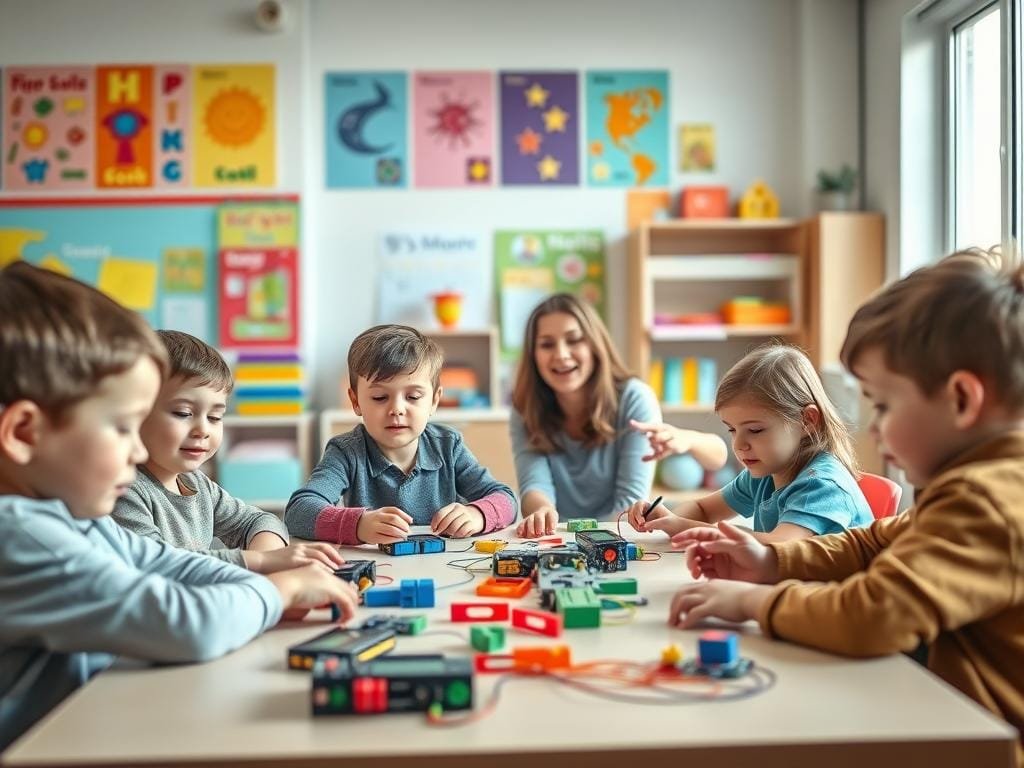
Middle School and Beyond (Ages 11+): Text-Based Coding Introduction
Older kids learn text-based coding. Python is a good language for beginners. It’s easy to learn and very useful.
Many coding websites for kids offer Python lessons. Coding apps for kids also support text-based coding. These tools help kids keep learning outside of school.
By matching coding lessons to the child’s age, you help them build a strong coding foundation. This prepares them for a future in technology.
Unplugged Coding Activities: No Computer Required
Unplugged coding activities are a fun way to teach programming to kids without a computer. They help kids think creatively, solve problems, and think critically.
Binary Bracelet Craft Project
The Binary Bracelet Craft Project lets kids learn about binary code by making bracelets. They turn their name or a simple message into binary. This teaches them how computers process information. Plus, they get a cool bracelet out of it.
Human Robot Instructions Game
In the Human Robot Instructions Game, one person is the robot, and others give instructions to move through an obstacle course. It shows the value of clear instructions in coding. It’s a fun way to see how computers follow commands and need precision.
Algorithm Sandwich Making Challenge
The Algorithm Sandwich Making Challenge has kids make a peanut butter and jelly sandwich using a specific algorithm. It teaches them about algorithms and the importance of following a sequence. It shows how order and detail are key in coding.
These activities are great coding resources for kids. They lay the groundwork for programming while encouraging creativity and problem-solving. By doing these fun, computer-free activities, kids gain a solid understanding of coding. This will help them when they start using computers.
Block-Based Programming DIY Projects for Beginners
For young beginners, block-based programming projects are a fun way to start coding. They use visual blocks instead of text, making it easier and more fun for kids to learn.
There are many block-based programming DIY projects great for kids starting to learn coding. You can make interactive animations, maze games, and digital stories.
Creating an Interactive Pet Animation with Scratch
One fun project is making an interactive pet animation with Scratch. Kids can use Scratch to code animations and stories. They can learn about event-driven programming and how to handle user inputs by creating an interactive pet.
Building a Maze Game with Blockly
Building a maze game with Blockly is another fun project. Kids create a maze and code a character to move through it. They learn problem-solving and logical thinking while improving their coding skills.
Digital Storytelling with ScratchJr
Digital storytelling is a creative way for kids to express themselves. With ScratchJr, they can make interactive stories and animations. This project helps them develop their storytelling skills and learn about sequencing and timing in coding.
These projects not only teach coding but also boost creativity and problem-solving. They are perfect for young learners interested in coding games for kids and online coding for kids.
Introducing Python with Fun Interactive Projects
Teaching kids Python can be both fun and rewarding. Python is easy to learn and great for many projects. It’s perfect for kids to start coding.
There are many fun projects to help kids learn Python. Here are a few examples:
Drawing Geometric Art with Turtle Graphics
Turtle Graphics is a great way to introduce Python. Kids can make art by guiding a virtual ‘turtle’ on the screen. It teaches them about loops and if-else statements.
Creating a Personalized Quiz Game
Kids can make their own quiz game with Python. They design questions, score them, and show results. This teaches them about variables and how to control the flow of a program.
Building a Math Helper Calculator
Building a calculator helps kids with math in Python. They learn about functions and how to handle user input. It makes math more fun and interactive.
For more Python projects for kids, check out CodeWizardsHQ. They have lots of coding projects and tutorials for young learners.
| Project | Skills Learned |
|---|---|
| Drawing Geometric Art | Loops, Conditional Statements |
| Personalized Quiz Game | Variables, Data Types, Control Structures |
| Math Helper Calculator | Functions, User Input Handling |
These projects help kids learn Python and improve their problem-solving, logical thinking, and creativity. These skills are key for success in today’s tech world.
Coding for Kids: Hands-On Robotics and Physical Computing
Kids can dive into exciting hands-on robotics and physical computing projects. These activities teach programming concepts and boost creativity and problem-solving skills.
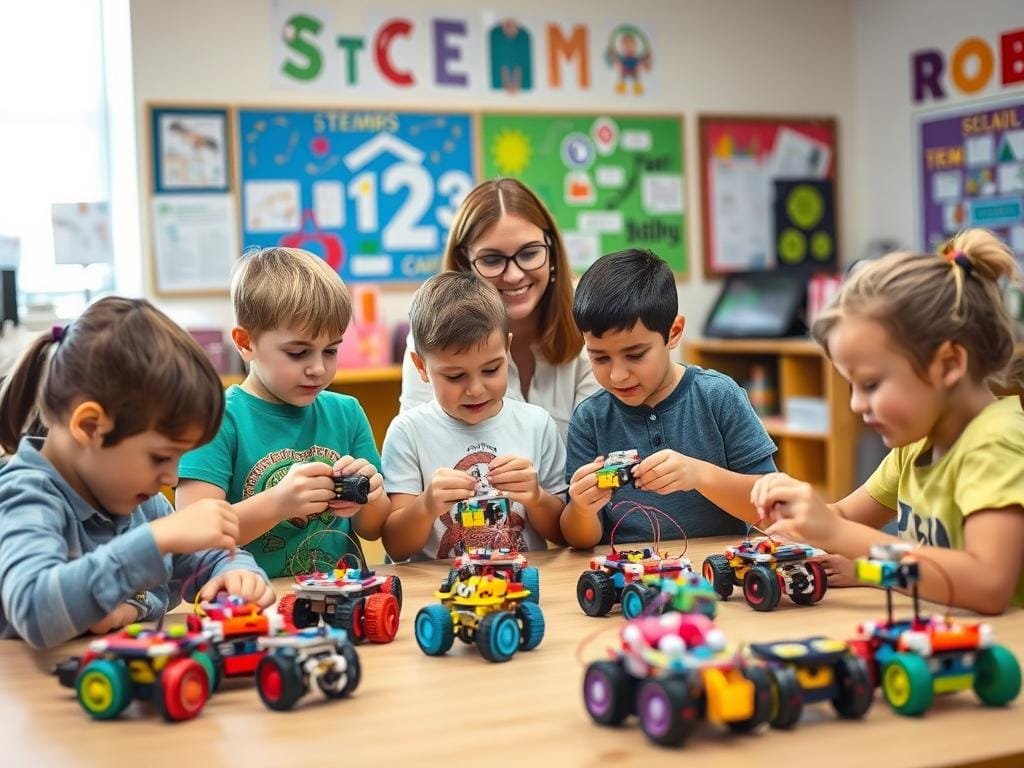
Programming a LEGO Mindstorms Obstacle Course Robot
LEGO Mindstorms is great for introducing kids to robotics and programming. Building and programming an obstacle course robot teaches about sensors, motors, and conditional statements. Kids can try different algorithms to improve their problem-solving skills.
For more info on robotics programming for kids, check out Tynker’s Robotics Programming Blog. It has valuable insights and resources.
Creating Musical Instruments with Makey Makey
Makey Makey lets kids turn everyday objects into touchpads and make musical instruments. By coding, kids can create interactive projects that make sound or music. This introduces them to input/output devices and basic circuitry.
Building an LED Light Show with Arduino
Arduino is a top choice for physical computing projects. Kids can build an LED light show to learn about programming microcontrollers. They understand how to control LEDs with code, learning about loops, conditional statements, and electronics basics.
These hands-on projects help kids grasp coding concepts and their real-world uses. For more on technology in daily life, see Digital Vista Online’s article on ambient computing.
Web Development Projects for Young Creators
Coding websites for kids is a fun way to teach them about online coding for kids and web development. It lets them build and design their own websites. This empowers young creators.
Web development is creative and rewarding. It lets kids express their ideas online. Start with simple projects and move to more complex ones. Here are some exciting web development projects for young creators:
Building a Personal Profile Page with HTML and CSS
Creating a personal profile page is a great way for kids to learn HTML and CSS. They can design a webpage that shows their interests, hobbies, and achievements. This project teaches them web development basics and how to structure content online.
Creating an Interactive Story Website with JavaScript
By using JavaScript, kids can make interactive story websites. This project introduces them to dynamic web content. It shows how to make websites more interactive.
Designing a Family Photo Gallery with Simple Code
Designing a family photo gallery is a fun project. It teaches kids about web development. They learn to organize and display content in an attractive way, using simple code.
For more information on web development for kids, visit CodeYoung’s guide to web development. This resource offers a detailed introduction to web development concepts for young learners.
Mobile App Development DIY Projects
Creating mobile apps is a fun and challenging project. It teaches kids about user interface design and coding. With tools like App Inventor, kids can develop their own apps, learning valuable skills in the process.
Creating a Custom Drawing App with App Inventor
App Inventor is a great platform for kids to start developing mobile apps. By creating a custom drawing app, kids can learn about user interface design and basic coding concepts. This project allows them to express their creativity while developing a useful app.
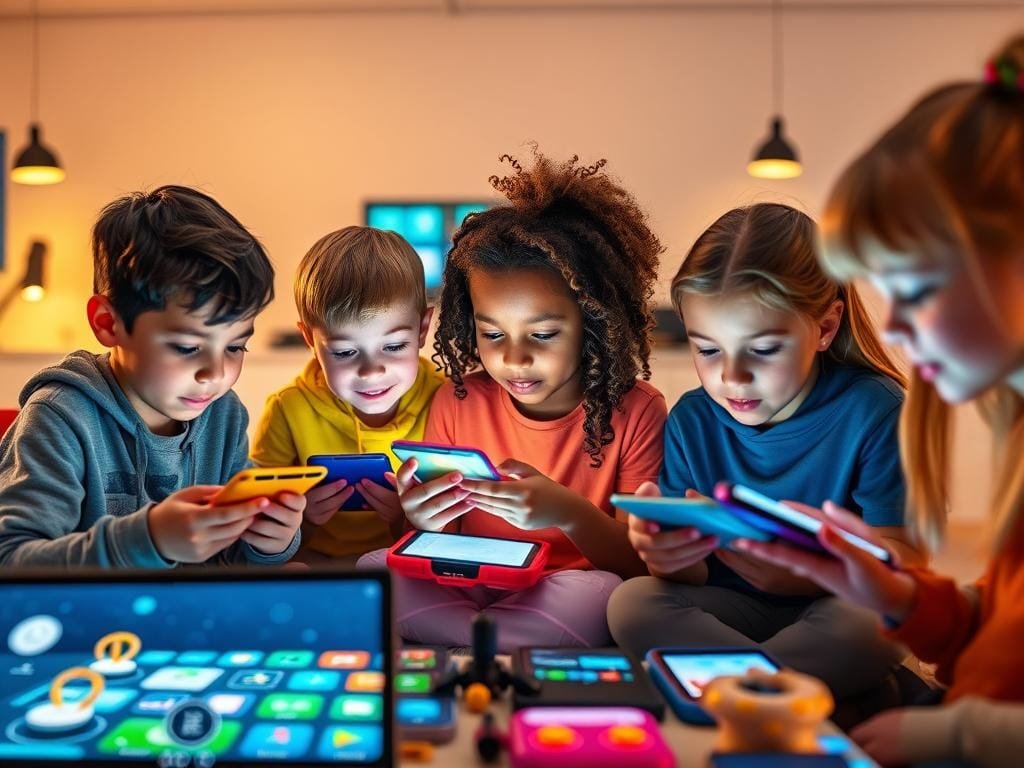
Building a Reaction Time Game App
Building a reaction time game app is another engaging project for kids. It teaches them about game development, user interaction, and how to code simple game logic. This project helps kids understand how to design a fun and interactive app.
Developing a Homework Helper Tool App
Developing a homework helper tool app is a practical project. It shows kids how to create something useful. By designing an app that can assist with homework, kids learn about problem-solving and coding for real-world applications.
For more information on mobile app development for kids, you can visit CodeWizardsHQ. They offer a detailed guide to web and mobile app development.
Overcoming Common Challenges in Teaching Kids to Code
Keeping kids interested in coding can be tough. To solve this, try project-based learning. This lets them work on coding projects that they find exciting.
Maintaining Interest Through Project-Based Learning
Make coding fun and challenging for kids. For example, building a simple game or creating a digital story can introduce programming concepts in a fun way.
Developing Debugging Skills and Resilience
Debugging is key in coding. Teach kids to see errors as chances to learn, not failures. This builds resilience and sharpens problem-solving skills.
Balancing Screen Time with Productive Coding Education
Coding does involve screen time, but it’s important to find a balance. Use coding resources for kids that include offline activities. This could be coding puzzles or games without screens.
With these strategies, you can make coding education more engaging and effective for kids.
Essential Resources and Tools for Young Coders
There are many tools and resources to help kids learn coding. Parents and teachers can pick the best ones for their needs.
Free Online Platforms and Learning Communities
Many online platforms offer free coding resources for kids. Brightchamps is one that provides interactive coding lessons. Other great sites include Scratch, Code.org, and Tynker.
These websites have coding tutorials for all skill levels. They are perfect for kids of different ages and abilities.
Recommended Books and Learning Materials by Age Group
Books are a great way to learn coding. For younger kids (ages 4-8), “Robots, Robots, Everywhere!” and “Coding with Emma” are good choices. They introduce basic coding ideas.
For older kids (ages 9-12), “Python for Kids” by Jason R. Briggs is a great book. It offers a deep dive into programming.
Coding Camps and Classes
Coding camps and classes give kids hands-on experience. They learn from experienced teachers, both online and offline.
In-Person Workshop Options
Local communities and coding schools have in-person workshops. These are great for kids to learn and meet others with similar interests.
Virtual Learning Opportunities
For online learning, there are many virtual coding camps and classes. They are flexible and can be accessed from anywhere. This is perfect for kids with busy schedules.
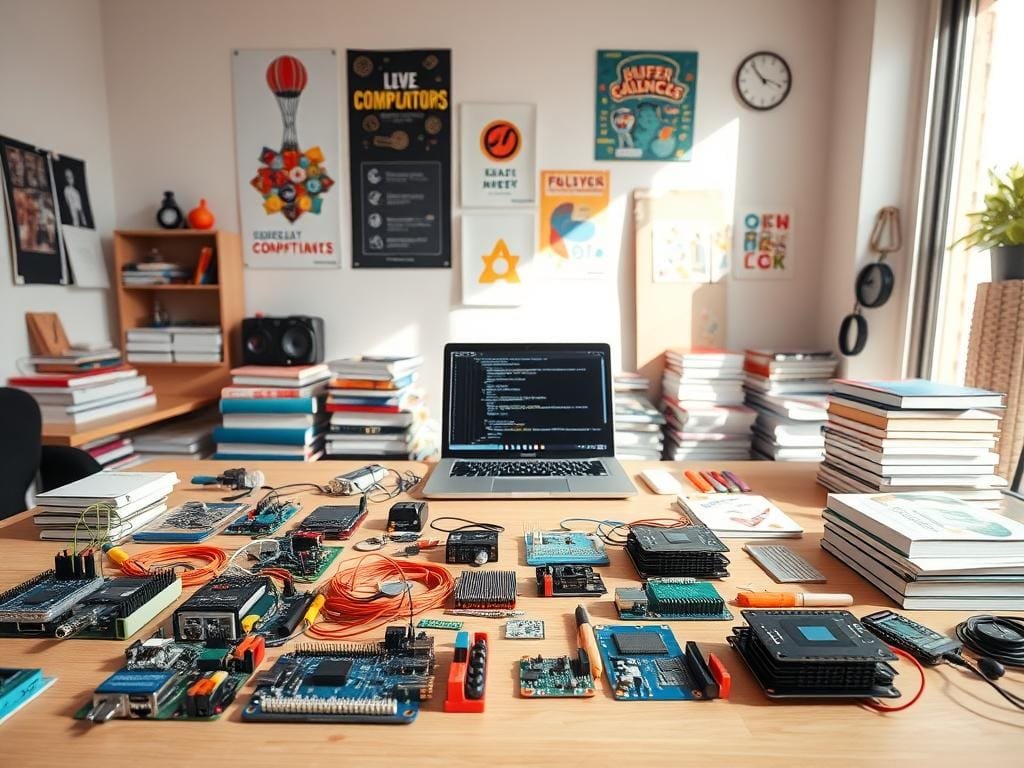
Kids can have fun learning to code with these resources. Whether it’s online, through books, or coding camps, there’s something for every young coder.
Conclusion: Nurturing the Next Generation of Innovators
Introducing kids to coding can change their lives. It boosts their thinking skills, digital smarts, and job chances. By teaching them to code, you’re helping them become the innovators of tomorrow.
Steve Jobs believed everyone should learn to code. He said it teaches you to think differently. By signing your kids up for kids coding classes, you’re giving them a new way to solve problems.
Start coding with your kids today. Watch them become confident and creative. With the right help, they can achieve great things and change the world.
FAQ
What is the best age to start teaching kids to code?
You can start teaching coding to kids as young as 3-5 years old. Use fun activities and visual programming basics. As they get older, move to more complex coding methods and tools.
What are some fun coding games for kids to learn programming concepts?
There are many games that make learning fun. Kids can create animations with Scratch, build maze games with Blockly, and make interactive stories with ScratchJr. Online platforms also offer coding challenges and games.
How can I introduce Python to my kids, and what are some interactive projects we can work on together?
Introduce Python with projects like drawing with Turtle Graphics, making a quiz game, or a math calculator. These projects make learning Python fun and engaging.
What are some hands-on robotics and physical computing projects suitable for kids?
Projects like programming a LEGO Mindstorms robot, making musical instruments with Makey Makey, or an LED light show with Arduino are great. They help kids solve problems and learn about robotics and physical computing.
What are some online resources and tools available for kids to learn coding?
Online platforms like Code.org, Scratch, and CodeCombat offer coding lessons. Apps like Hopscotch and Tynker, and websites like KidCoder and CodeMonkey are also good resources.
How can I balance screen time with productive coding education for my kids?
Mix online coding activities with offline projects like coding crafts and robotics. This balance keeps kids engaged without too much screen time.
What are some recommended books and learning materials for kids to learn coding?
Books like “Code Like a Girl” and “Python for Kids” are great. Online resources like Coding for Kids and Kid’s Coding Academy also offer learning materials for different ages.
Are there any coding camps or classes available for kids?
Yes, many organizations offer coding camps and classes for kids. Look for local camps, clubs, or online programs that fit your child’s age and skill level.
How can I support my child’s coding journey and help them overcome common challenges?
Encourage project-based learning and help develop debugging skills. Hands-on activities and guidance can help your child overcome challenges and stay motivated.
